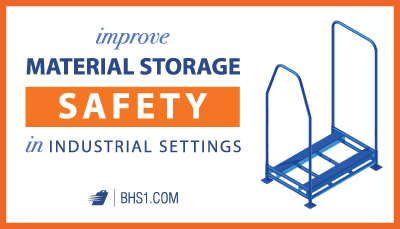We use cookies to make your experience better. To comply with the new e-Privacy directive, we need to ask for your consent to set the cookies. Learn more.
Improve Material Storage Safety in Industrial Settings
"Material storage" is a simple term for a pretty complex topic. If all the materials that workers in factories, warehouses, and construction sites use fit onto pallets, everything would be much simpler. Here in the real world, though, industrial staff have to learn how to handle and store cylinders, drums, heavy bags, bundles, tubes, and just about any other configuration of matter you can think of.
Handling these materials is hard enough. Storing them comes with a whole new set of challenges. Luckily, experts have studied the issue of storing materials that can't be simply built onto a pallet. Here are a few tips from OSHA and other material handling specialists about how to improve safety while storing common industrial products: 
-
Use specialized material racks.
OSHA guidelines on material handling and storage encourage employees to try "placing bound material on racks, and [securing] it by stacking, blocking, or interlocking to prevent it from sliding, falling, or collapsing." In nearly the same breath, they tell us to "separate noncompatible material."
Taken together, these two recommendations argue for the use of multiple highly specialized material racks, built expressly for the materials in your warehouse. You wouldn't stack bags on a sheet-glass storage unit, and your glass wouldn't last long on a simple ground rack. The solution is to consider your materials, and choose storage racks that are built to provide support for each type of product stored in your facility.
-
Know your weight limits.
The second step to matching safe, secure storage racks to industrial materials may seem obvious, but people sometimes overlook it, to their peril. Never go over a storage unit's designated weight limit.
In general, this means you should choose storage racks that are made of heavy-duty steel, with weight limits that greatly exceed the loads you plan on storing there. Ground Racks and Sheet Material Racks from BHS, for instance, have load capacities of 8,000 pounds.
-
Don't stack kegs, drums, or barrels directly on top of one another.
Instead, always use a pallet or wooden planks between layers. This creates a stable, flat surface for upper layers to rest upon.
-
When stacking lumber, keep stacks relatively short and be sure to remove embedded nails.
OSHA recommends capping stacks of lumber at 16 feet high in applications where workers handle these materials manually. If you use mechanical material handling equipment to access lumber, OSHA recommends a maximum stack height of 20 feet.
Not only do nails pose hazards for workers handling used lumber, they make it impossible to safely stack this common building material. It may be time consuming, but it pays to remove all nails from lumber before placing it into storage.
-
Block stacks of cylindrical materials, such as bar stock and lengths of conduit, at each end to prevent a collapse.
Poles, steel bars, and conduit pose unique storage challenges. When placed into the wrong racks, they can easily roll over one another, prompting a dangerous avalanche of heavy materials. That's why OSHA tells us to block stacks of cylinders at each end, to keep them secure in their storage racks. Ground Racks from BHS include removable restraints for the greatest combination of safety and access for all types of materials.
The takeaway here is that the way you store materials is just as important as the way you move them from one place to another. Both tasks can become dangerous when you don't have the appropriate equipment.
With heavy-duty racks designed specifically for awkwardly shaped building and industrial materials, however, it's easy to keep your stock safe and secure. Even better, that keeps your employees safe.
References:
"Materials Handling and Storage." OSHA. Occupational Safety and Health Administration, United States Department of Labor, n.d. Web. 15 May, 2017.
